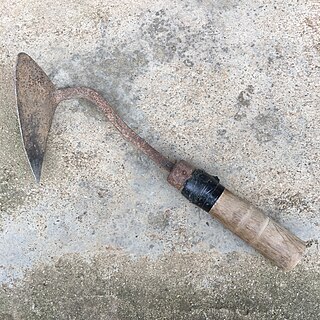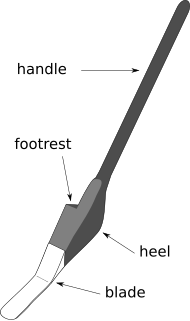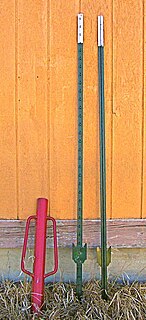 W
WIn farming and gardening, the broadfork, also called a U-fork or grelinette, is a tool used to manually break up densely packed soil, including hardpan, to improve aeration and drainage. Broadforks are used as part of a no-till or reduced-till seedbed preparation process because they preserve the soil structure and avoid the resurfacing of weed seeds.
 W
WA captive bolt is a device used for stunning animals prior to slaughter.
 W
WA cattle prod, also called a stock prod or a hot stick, is a handheld device commonly used to make cattle or other livestock move by striking or poking them. An electric cattle prod is a stick with electrodes on the end which is used to make cattle move through a relatively high-voltage, low-current electric shock. The electric cattle prod is said to have been invented by Texas cattle baron Robert J. Kleberg, Jr. of the King Ranch around 1930, although versions were sold as early as 1917.
 W
WIn agriculture and gardening, a cloche is a covering for protecting plants from cold temperatures. The original form of a cloche is a bell-shaped glass cover that is placed over an individual plant; modern cloches are usually made from plastic. The use of cloches is traced back to market gardens in 19th century France, where entire fields of plants would be protected with cloches. In commercial growing, cloches have largely been replaced by row cover, and nowadays are mainly found in smaller gardens.
 W
WA dibber or dibble or dibbler is a pointed wooden stick for making holes in the ground so that seeds, seedlings or small bulbs can be planted. Dibbers come in a variety of designs including the straight dibber, T-handled dibber, trowel dibber, and L-shaped dibber.
 W
WA hay knife is an agricultural hand tool: a long-bladed knife which may have large rounded serrations on the edge, or a smooth edge used for sawing off sections at the end of a stack or compact pile of hay or silage. In the south of England hay knives may have smooth edges.
 W
WHomi, also known as a Korean hand plow, is a short-handled traditional farming tool used by Koreans. It is a farming tool that removes grasses from paddies and fields. It is also used when plowing a rice field, planting seeds, plowing up soil, and digging potatoes in fields. It is a farming tool similar to the hoe. It is an important extension of agriculture from the ancient times because the homi was excavated in the Bronze Age historic site of the Pyeongnam Mangsan Daepyeong-ri and the early Iron Age historic site of Yangpyong, Gyeonggi Province.
 W
WKajandu is a long-handled fulcrum shovel used by the Jola (Diola) people of Senegal, Gambia, and Guinea-Bissau to till and prepare rice paddy fields. It is also used to make dikes and furrows. It consists of a long wooden shaft, 1.6–3.5 metres long, and a large flat or concave wooden blade with iron edges. The long shaft rests on the knee and is used to lift up pieces of earth. Typically men use the kajandu while women sow, replant, spread manure and harvest.
 W
WThe laia is a two-pronged type of foot-plough used in the Basque Country. Aside from being a farming implement, it is also used in laia racing. The people using a laia are referred to as laiariak in Basque.
 W
WA loy is an early Irish spade with a long heavy handle made of ash, a narrow steel plate on the face and a single footrest. The word loy comes from the Irish word láí, which means "spade". It was used for manual ploughing prior to and during the Great Famine.
 W
WA nose ring is a ring made of metal designed to be installed through the nasal septum of pigs as well as domestic cattle, usually bulls. In pigs, nose rings are alternatively installed through the rim of the nose. Nose rings are often required for bulls when exhibited at agricultural shows. There is a clip-on ring design used for controlling and directing cattle for handling. Nose rings are used to encourage the weaning of young calves by discouraging them from suckling.
 W
WA pig scalder is a tool that was used to soften the skin of a pig after it had been killed to remove the hair from its skin. Because people rarely slaughter and process their own pigs anymore, pig scalders are seldom used for domestic use.
 W
WA pitchfork is an agricultural tool with a long handle and two to five tines used to lift and pitch or throw loose material, such as hay, straw, manure, or leaves.
 W
WA plough or plow is a farm tool for loosening or turning the soil before sowing seed or planting. Ploughs were traditionally drawn by oxen and horses, but in modern farms are drawn by tractors. A plough may have a wooden, iron or steel frame, with a blade attached to cut and loosen the soil. It has been fundamental to farming for most of history. The earliest ploughs had no wheels; such a plough was known to the Romans as an aratrum. Celtic peoples first came to use wheeled ploughs in the Roman era.
 W
WA post pounder, post driver, post rammer, post knocker or fence driver is a tool used for driving fence posts and similar items into land surfaces. It consists of a heavy steel pipe which is closed at one end and has handles welded onto the sides. It is normally used by one person, but larger versions may require two.
 W
WA Pyecombe hook is a distinctive shepherd's crook crafted in the old forge at the village of Pyecombe in Sussex, England since the 19th century. The Pyecombe hook was perfectly balanced with a twist that allowed shepherds to easily catch the hind leg of a sheep without injuring the sheep. Its use is described by Charles Mitchell: “the curve is made so that the shepherd can hook it around the sheep’s leg, slide it up, give it a slight twist, and the sheep is caught fast without being in the least hurt.” It was often made out of old gun barrels.
 W
WIn agriculture and gardening, row cover is any transparent or semi-transparent, flexible material, like fabric or plastic sheeting, used as a protective covering to shield plants, usually vegetables, primarily from the undesirable effects of cold and wind, and also from insect damage. In addition to reducing the drying effect of wind, row cover can provide a limited amount of warming by the same effect that cold frames, greenhouses, and polytunnels produce, creating a microclimate for the plants.
 W
WA scythe is an agricultural hand tool for mowing grass or harvesting crops. It is historically used to cut down or reap edible grains, before the process of threshing. The scythe has been largely replaced by horse-drawn and then tractor machinery, but is still used in some areas of Europe and Asia. Reapers are bladed machines that automate the cutting of the scythe, and sometimes subsequent steps in preparing the grain or the straw or hay.
 W
WA shepherd's crook is a long and sturdy stick with a hook at one end, often with the point flared outwards, used by a shepherd to manage and sometimes catch sheep. In addition, the crook may aid in defending against attack by predators. When traversing rough terrain, a crook is an aid to balance. Shepherds may also use the long implement to part thick undergrowth when searching for lost sheep or potential predators.
 W
WA sickle, bagging hook, reaping-hook or grasshook is a single-handed agricultural tool designed with variously curved blades and typically used for harvesting, or reaping, grain crops or cutting succulent forage chiefly for feeding livestock, either freshly cut or dried as hay. Falx was a synonym but was later used to mean any of a number of tools that had a curved blade that was sharp on the inside edge such as a scythe.